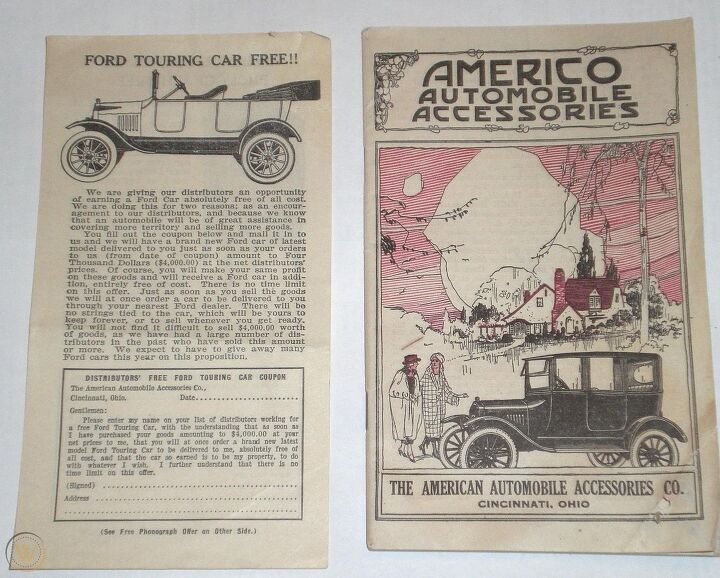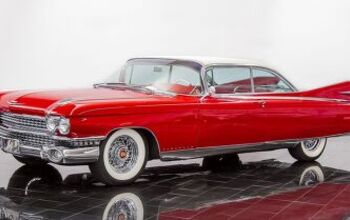Rare Rides Personas: Powel Crosley Junior, Tiny Cars, Radio, and Baseball (Part III)

We pick up our coverage of the life and times of Powel Crosley Jr. in 1916. At 30 years old, Crosley had a spouse of six years and two young children. He’d given up car-selling ventures in Indiana for a permanent return to his native land of Cincinnati.
His experiences in car sales and hype in Indiana turned the inventor into a marketing man, and Crosley’s main source of income was ad copy. He did that in between short-lived side jobs at small local automotive companies (that all went bust). All the while Crosley kept one eye on the automobile market and took notice of just how common and numerous the automobile had become on American roads. It was almost time for a new car venture.
The American roadway opened up in front of consumers in the first two decades of the 20th century. By 1916 there were almost a million Model T Fords in circulation, and the Lincoln Highway spanned the country. Americans were suddenly covering more miles in their cars, and driving further than before. The increase in distance traveled showed a big failing in car tire design of the day: Their fragility. Enter a familiar tire name, Cooper.
One of Crosley’s repeat ad customers was the Cooper Tire Company. The main function the company served at the time was not new tire manufacture, but retreading worn out tires. Slightly used treads were added to tires that had worn out, and boy does that sound safe. Said tires could only have so much tread rework before they were useless. And that meant many thousands of tires piled up across the country.
That wasn’t the only issue with tires. Durability was a big problem, as a new tire usually lasted less than 1,000 miles given the road conditions. Tires at the time had two basic layers: The outside rubber and the inner tube. Without much insulation between the tire and the tube (and considering they’d often been retreaded), road imperfections and debris meant blowouts were common. The blown tires were thrown in the pile with the worn ones.
Ira J. Cooper (1874-1941), native Ohioan and founder of Cooper Tire, had some ideas on how to improve the tire and upcycle the old rubber into a usable product. His idea was a liner that would surround the inner tube with a layer of protective rubber. But he needed an inventor to work out the engineering details! Turned out he knew one already, and called on Crosley. Crosley worked up the requested invention, and called it the Inside Tyre.
The Insyde Tyres promised to double the mileage of any tire, and prevent punctures and blowouts. It was a simple job to add the liner to the tire a customer already owned and did not require any tools. The new product needed marketing and distribution, so Crosley personally set up the franchise system for the product. It was an immediate success. Crosley felt a new company was in order to push the Insyde Tyre properly.
Given the growth of automobile usage, the number of different kinds of cars on the road, and the generally tough conditions in which cars operated in the early 20th century, the car parts and accessories market heated up quickly. With the Insyde Tyre as its premier product, Crosley partnered with Ira Cooper and founded the American Automobile Accessories Company in 1916.
In marketing the company’s Cincinnati, Ohio location was stated prominently, and the company name was shortened to Americo Automobile Accessories. Naturally, Crosley served as ad copywriter and marketer for Americo in addition to his inventor responsibilities. Advertisements indicated that dealers and agents for the Insyde Tyre were needed urgently.
Crosley added to the company’s product portfolio quickly, and Americo expanded to sell various other car accessories and parts. Crosley invented some of the parts himself, though the Insyde Tire remained the best seller. Cooper was not all that interested in parts other than tires and allowed Crosley to buy him out of Americo in short order.
Though he excelled at inventing and marketing, Crosley was not the business and accounting sort and needed a new partner. He brought in his younger brother Lewis to run the office side of Americo. The company grew quickly and became one of the very first major aftermarket car accessory firms. Powel invented the car parts consumers wanted and marketed them, and Lewis ensured they were built to a high standard for the best price.
One of his early inventions was a flag holder that enabled Americans to show their patriotism during World War I. The flag holder clamped to a radiator cap and could display up to five flags. (Here’s a photo of one.)
Other inventions were functional rather than decorative, like a fuel additive called Kick. He also created a tire patch that self-vulcanized and called it Treadkote. There was a waterless car-wash product, too. Perhaps most interesting was the “Lil Shofur,” which attached to the steering (somehow) and helped to return it to center.
Crosley had an eye for what the average consumer wanted to screw, clamp, stick, or otherwise add to their cars. Three years in (1919) Americo had sold over $1 million ($17,125,780 adj.) of product. Both brothers felt the company was ready to branch into products outside the automotive realm, and that’s exactly what they did.
It happened to be a great time to expand into the home sound system of the day, the phonograph. RCA had a patent on the Victrola phonograph, but it recently expired. The Victrola was around $100 ($1,712 adj.) in 1919, and totally out of the reach of most consumers. Crosley knew he could one-up RCA for less money, and leaned into his experience with radios and sound from childhood.
A year later in 1920, American Automobile Accessories debuted the Amerinola. It was similar to the Victrola but sold for half the price. Commonly marketed as “Talking Machines,” the Amerinola was manufactured by Amerinola Co. in Cincinnati, a division of American Automobile Accessories. Its name was very similar to the Amberola of the Thomas Edison company, which was also $100 like the RCA.
With home audio success almost instantly secured, there was another audio segment where Crosley also saw growth potential: Radio. Much like his father had done, Powel Jr. taught a young Powel Crosley III about radio.
Commercial radio was just getting its start in America, with companies like Westinghouse, RCA, GE, and AT&T operating their own broadcast stations. Around eight years old at the time, Powel III asked his father to go and purchase a radio at an electronics store. Crosley entered and asked about the price, a shocking $130 ($1,925 adj.)!
Surely if his company could construct a value-priced and quality-made phonograph for the average consumer, it could do the same in the radio market. Crosley bought a booklet from the store entitled The ABCs of Radio, and left with ideas for the next new product from Amerinola Co. Crosley was about to enter the world of radio in a big way, and establish another new company to sell the “Crosley Radio Apparatus.” See you in Part IV.
[Images: Americo, ABC, Edison Co.]
Become a TTAC insider. Get the latest news, features, TTAC takes, and everything else that gets to the truth about cars first by subscribing to our newsletter.

Interested in lots of cars and their various historical contexts. Started writing articles for TTAC in late 2016, when my first posts were QOTDs. From there I started a few new series like Rare Rides, Buy/Drive/Burn, Abandoned History, and most recently Rare Rides Icons. Operating from a home base in Cincinnati, Ohio, a relative auto journalist dead zone. Many of my articles are prompted by something I'll see on social media that sparks my interest and causes me to research. Finding articles and information from the early days of the internet and beyond that covers the little details lost to time: trim packages, color and wheel choices, interior fabrics. Beyond those, I'm fascinated by automotive industry experiments, both failures and successes. Lately I've taken an interest in AI, and generating "what if" type images for car models long dead. Reincarnating a modern Toyota Paseo, Lincoln Mark IX, or Isuzu Trooper through a text prompt is fun. Fun to post them on Twitter too, and watch people overreact. To that end, the social media I use most is Twitter, @CoreyLewis86. I also contribute pieces for Forbes Wheels and Forbes Home.
More by Corey Lewis
Latest Car Reviews
Read moreLatest Product Reviews
Read moreRecent Comments
- Turbo Is Black Magic My wife had one of these back in 06, did a ton of work to it… supercharger, full exhaust, full suspension.. it was a blast to drive even though it was still hilariously slow. Great for drive in nights, open the hatch fold the seats flat and just relax.Also this thing is a great example of how far we have come in crash safety even since just 2005… go look at these old crash tests now and I cringe at what a modern electric tank would do to this thing.
- MaintenanceCosts Whenever the topic of the xB comes up…Me: "The style is fun. The combination of the box shape and the aggressive detailing is very JDM."Wife: "Those are ghetto."Me: "They're smaller than a Corolla outside and have the space of a RAV4 inside."Wife: "Those are ghetto."Me: "They're kind of fun to drive with a stick."Wife: "Those are ghetto."It's one of a few cars (including its fellow box, the Ford Flex) on which we will just never see eye to eye.
- Oberkanone The alternative is a more expensive SUV. Yes, it will be missed.
- Ajla I did like this one.
- Zerofoo No, I won't miss this Chevrolet Malibu. It's a completely forgettable car. Who in their right mind would choose this over a V8 powered charger at the rental counter? Even the V6 charger is a far better drive.







































Comments
Join the conversation
A free Model T Touring Car? Heck, I'd take one of those, even today. The ABC radio news ad has a few names I recognize - columnist Walter Winchell (he later narrated TV's "The Untouchables"), Drew Pearson, who was an accomplished journalist and writer, Dorothy Kilgallen, a columnist who later appeared on game shows in the '50s, like "What's My Line?", and Hollywood gossip columnist Louella Parsons.
Corey, do you have links for some of those ads? I'd like to be able to zoom in on them.